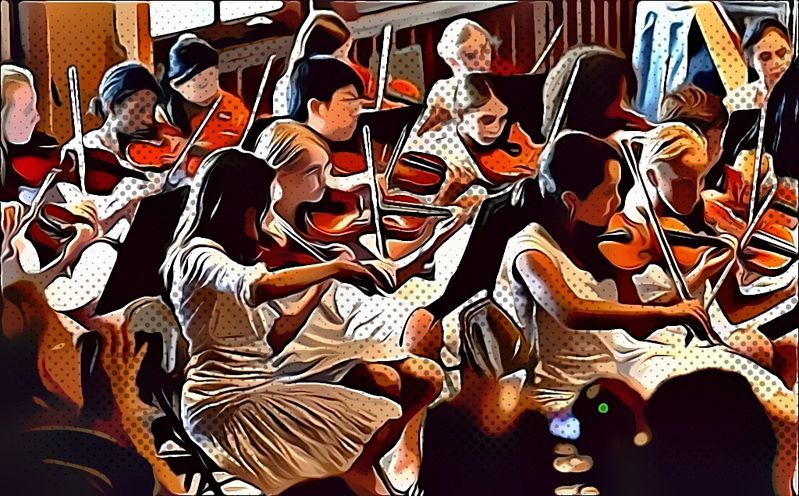
– Part 1: Design aspects
If you are involved in the design of a school for performing arts, you will require intense help from an acoustic consultant. They will tell you how to design your facilities to make it fit for the purpose of teaching, practicing and performing.
To start with, the consultant will base the advice on guidelines for general education facilities. In the UK, you need to achieve the standards set in the Building Bulletin 93 (BB93): Acoustic design of schools – performance standards.
Then they will extend the brief to take into account the special needs for performing arts facilities. It has to consider that:
- some spaces host loud activities with particular sound characteristics (especially in terms of spectrum)
- some spaces require specific listening and/or recording environments
Acoustic design of schools for performing arts Part 1 will explain which design aspects to consider for your building. Part 2 gives some tips for the early stages of the design.
Are you looking to understand how acoustic products work and find examples available on the market?
Visit the Acoustic Design Catalogue by following the button below.
Part 1 – Design aspects
For schools specialised in performing arts, excellent acoustic conditions are paramount for the users of the facilities.
The acoustic design of such a project focuses on the following aspects:
- the sound reverberation and the loudness within the spaces
- the sound insulation between the spaces
- the noise levels within the building
- the noise emissions related to the operation of the school
Sound Reverberation and Loudness
Sound Reverberation
This happens in a room when the sound of a source is reflected in multiple reflections that build up and decay as they are absorbed by the surfaces and the furnishing.
The reverberation characteristics of a room make its acoustic footprint. A little bit like an instrument that responds to an excitation with its own timbre.
Note: Reverberation is characterised by the reverberation time. It tells you how quickly the acoustic energy decays within the room and it is measured for different frequencies ranging from base, to medium and high.

The optimal reverberation conditions vary for every space depending on their use.
For most standard school spaces, the main sound sources are the teachers or the pupils talking. Therefore, it is enough to look at the reverberation characteristics at the frequencies of the human voice, i.e. the mid frequencies (generally between 500 Hz and 2000 Hz).
The frequency range of most instruments is wider than for the human voice. Most of them emit sound below 500 Hz. Therefore, particular attention needs to be made at low frequencies for spaces that regularly organise rehearsals and performances of acoustic music.
You generally tune the reverberation of a room with its finishes and its furniture.
(If you need to better understand what sound reverberation is, you can read Sound reverberation – Part 1: Basics)
Loudness (or Sound Strength)
The loudness of the rooms is worth considering. It represents their capacity to amplify or attenuate sound.
Although loudness needs to be right for any music space, it is critical for rehearsal and performance spaces. On one hand, instruments could sound too loud and unpleasant to the audience or the musicians themselves. On the other hand, sole singers, musicians or actors could sound too quiet during their performances.
So finding a balance between the sound reverberation and the loudness of music rooms is key to obtain ideal acoustic conditions.
The loudness is usually tuned with the dimensions, the surfaces and the finishes of the room.
Internal Noise Conditions
As introduced above, the noise conditions within a music school need to be right for teaching and learning, but also for listening and sometimes recording.
The noise in a building can come from various external and internal sources.
External Noise and Vibration Sources
External noise sources include:
- road traffic
- air traffic
- rail traffic
- plant and machinery located at neighbouring sites or serving the building
You can control external noise with:
- the façade/fabric of the building
- acoustic fences located between the source and the area that needs to be protected
- acoustic attenuators and/or acoustic enclosures to attenuate the noise from a single or multiple plant
- insulated casing to attenuate the noise breaking out of some plant
If the site is near a railway, you need to consider the vibrations created by the trains. They can propagate through the ground, be transferred in the building structure and be re-radiated into noise within the spaces.
You can control ground-borne vibrations by either:
- isolating the building structure with anti-vibration means (such as isolation bearings and/or heavy and stiff concrete foundations)
- isolating part of the rail tracks with anti-vibration means (such as isolation bearings and/or heavy and stiff concrete foundations)
- designing an in-filled trench between the building and the railway. But this is less common.
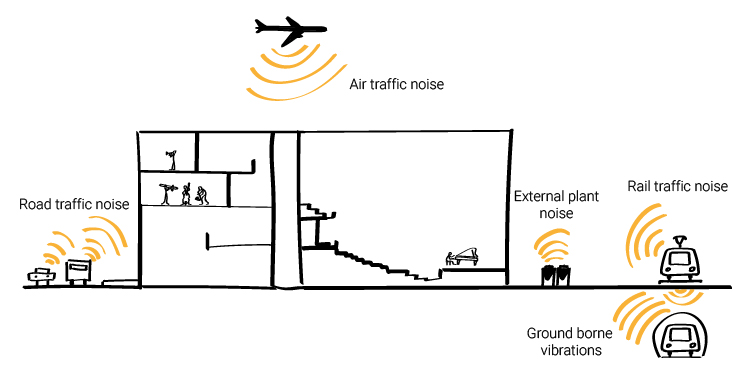
Internal Noise and Vibration Sources
Noise and vibration control for building services is a major task for the acoustic consultant. Especially for performing arts schools where some spaces need to operate in very quiet conditions.
The systems you need to watch are:
- the ventilation systems, that can not only carry noise (from a fan or outside depending on the ventilation strategy) but also regenerate noise
- the vibrations from the mechanical systems like the pumps, mechanical ventilation systems, lifts or lighting & stage equipment
- the services like the plumbing systems
- some electrical or lighting systems with for example transformers, dimmers or incandescent or fluorescent lights. They don’t generally make much noise. But when added together in larger spaces, they can be audible.
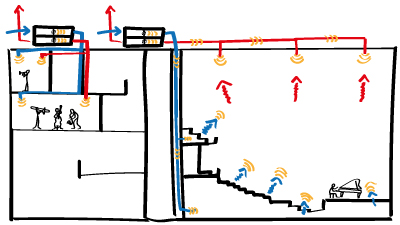

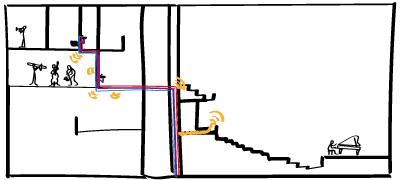
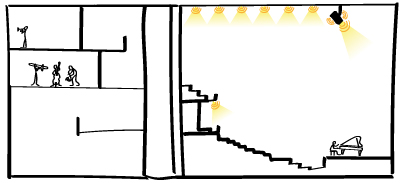
You can control the noise and vibration from building services with:
- attenuators and plenums for ventilation systems. It is also possible to adjust the airflow, change the ductwork or reselect the mechanical units
- anti-vibration systems (with neoprene mounts, isolation springs, resilient sleeves and other resilient materials) to decouple the vibrating elements from the structure
- reselecting the systems for quieter ones
Internal Sound Insulation (or Soundproofing)
Sound insulation looks at controlling the sound transfer between spaces through the walls and the floor constructions.
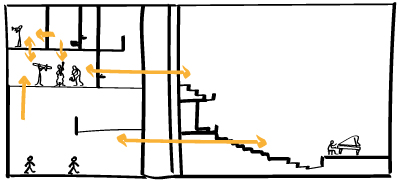
Whilst the performances targeted in normal schools are generally considered over a set frequency range (comprising low, mid and high frequencies together), some separations in performing arts schools require high performances with more considerations at low frequencies.
It is the case for partitions around spaces like recording studios, rehearsal rooms or performance spaces because:
- they require very quiet conditions to operate, so noise from other parts of the building need extra control
- they host louder activities, with a larger spectrum, that can cause disruption in other areas of the building
You can improve the performance of wall and floor build-ups by:
- adding more mass
- adding cavities
- decoupling the elements
- combining all the above
Operational Noise
Unless the school site is in the middle of nowhere, the local authority will ask you to control the noise from the operation of the school building. This is to avoid causing an adverse noise impact on the sensitive neighbours.
Examples of sensitive neighbours are residential properties, schools, hospitals and care homes.
Most of the time, you need to mitigate the noise from the external and internal plant serving the building, and the noise from practice, rehearsal or performance activities.
You also need to consider the noise generated by external sports and recreation areas.
You can control the noise that results from the operation of the school with:
- the façade/fabric of the building
- acoustic fences located between the source and the area that needs to be protected
- acoustic attenuators and/or acoustic enclosures to attenuate the noise from a single or multiple plant
- insulated casing to attenuate the noise breaking out of some plant
- avoiding operation during the quieter periods of the day. This is mostly applicable when the schools wish to operate or rent their activity area(s) in the evenings. The noise environment during evenings could be quieter than during the day and, if the areas are close to the sensitive receptors, the activities could be more noticeable and disturbing.

Sign up for the newsletter!
Once a month, Atelier Crescendo sends information such as recent activities, the last posts published on the Acoustic Blog, some acoustic tips, a review of some products recommended for acoustic design and some upcoming events/webinars.

